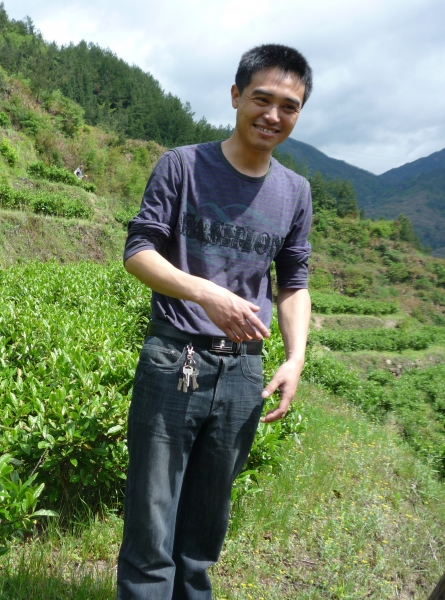Of all the tea blogs I’ve written, none have possessed the traction that my Nan Nuo Mountain coverage displayed. And I don’t mean in terms of viewership. (Let’s face it, what viewership?) But rather the enormity of vendors that specialize in single origin teas who’ve contacted me in its wake; I think the count is up to three? Point being, for that reason alone, it’s my new favorite post. Because of it, I wouldn’t have run into So-Han Fan.
Said wacky gent is the proprietor of West China Tea Company, which (I’m guessing) is a fairly new outfit. I’d never heard of it before, and I’ve been around. (Er…not like that.)
So-Han’s primary focus is – as the company name implies – teas from Western China, with a strong emphasis on Yunnan. He contacted me via my “normal” website, and mentioned that he carried two unique teas from Nan Nuo Shan (my favorite mountain, remember?). That and he also mentioned digging my tea fiction. Way to butter up the blogger, S-H. *heh*
Point being, I was more than excited to experience other teas from Nan Nuo, but when they arrived…there was a dilemma. I couldn’t tell the two apart. S-H had mentioned in the e-mail that I’d be able to identify them easily…but my blind eye-‘n-taste-testing skills weren’t that…uh…honed.
Both looked (and smelled) like loose sheng pu-erhs.

Sure, one smelled grapier than the other, but I needed a bit more of a walkthrough with these. S-H gladly got back to me about the two teas. When he finally identified them, my mouth was agape.
One of them was a black tea.
Unroasted Yunnan Hong Cha
The process – as described to me – for making this tea was…confusing. As far as I know, the leaves don’t go through a standard quickening of the oxidation process. (I.e. No cooking, roasting, pan-frying, kill-greening, speed-drying, what-have-you.) Instead, the leaves are…uh…massaged every two-to-three hours after picking to hasten the drying/dying process. In other words, old school oxidation by way of hand.
As I mentioned above: When I first received this sample, it was hard to tell it apart from a regular loose sheng pu-erh. The only thing that differed was the color of the leaves themselves – ranging from green-brown to black. However, the aroma was indiscernible from a sheng, which probably can be attributed to its “raw”-ness.
For brewing, I decided to do as the West China Tea Co. website suggested, and went with a gongfu-ish prep. They recommended a pre-wash…but I always end up drinking the pre-wash anyway. So, three steeps to start – each at thirty-to-forty-seconds.

The results were dark amber infusions with earthy-to-floral aromas. Nothing special was leaping out at me, yet. Then I took a sip. Holy whoah. It was like someone decided to see what would happen if a high altitude black tea made sweet-sweet love to a young sheng pu-erh. Flavors present were flowers, fruit, earth, sweetened wood, and…blanket.
Yes, blanket. This was one heckuva relaxing black tea. I just wanted to curl up with it, and talk about our future plans together.
Nan Nuo High Mountain Immortal Dew 2009 Loose Sheng Pu-Erh
Probably one of the most unique aged shengs I’ve come across. It was made in a small village called Duo Yi, at the summit of Nan Nuo.

Photo taken (and owned by) Villie Jokinen
No paved roads lead to the village, and many of the tea trees in the area range from 700-to-900 years old. This Nan Nuo sheng wasn’t commonly prepared for export, but rather used for everyday drinking for the Hani folks that prepared it.
The leaves were just as long and twisty as the Nan Nuo hong cha, but greener and wider. Plus, the scent they gave off was straight grapes. I’ve only ever encountered one other pu-erh that had that aromatic effect. Said smell also helped me tell the two teas apart.
In a typical gongfoolish fashion, I brewed about a tablespoon of the long leaves in a 6oz. gaiwan – using boiled water. Each infusion was roughly thirty seconds. To be honest, I wasn’t keeping accurate count.

The result was three starter steeps of bright green-to-amber liquors wafting springtime scents of lemon and grapes. On taste, the grape lean continued even stronger. There was a winy note to the pu-erh, one that comes with at least five years of age. The sensation was like tasting a heated Riesling. In more oblique terms, it was like being fed grape juice that was pulverized by the feet of a goddess.
Nan Nuo pu-erhs still have no equal.
Favorite?
I have to be an indecisive schmuck again. Everyone’s a winner here. I’m so beyond ecstatic that I got to try such a rare black tea from the mountain, and even more stoked that there was a new style of Nan Nuo pu-erh I hadn’t tried yet. The only thing that’s settled is that Nan Nuo Shan is now on my tea-do vacation list.
Paved roads or no.












